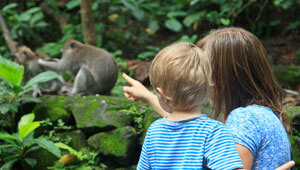How to Have a Roaring Good Time at the Zoo


Preschoolers are all about new adventures, especially ones that offer an abundance of wow-worthy behavior. What better place to find corrals-full of fantastic creatures to captivate your little one than the zoo? To make your trip especially memorable, Cindy Wallace, a mother and education manager at the San Diego Wild Animal Park (https://zoo.sandiegozoo.org/), sister facility to the San Diego Zoo, offers tips for an outstanding zoo safari.
Before You Go
Pick a theme. Color, for instance. Suggest to your child, “Let’s see how many different colors we can name at the zoo. What color do you think the monkeys will be? Will all the frogs be the same color? What about the lily pads they sit on?” Talking about your theme provides a sense of purpose for the trip and helps reign in what might otherwise become overwhelming. A theme such as color can also help your child articulate her burgeoning visual observations. You can start the game by naming the different colors of flowers and plants at home or the spots on the neighbor’s dog. Other possible topics include different types of ears (pointy or floppy), coverings (scales, fur, feathers), or animal sounds (growl, hoot, screech).
Read about animals. Looking through picture books together or watching movies featuring animals can get your child excited about the upcoming visit.
Search the Web site, if there is one, or call the main number for updated information. You may discover that there are new bear cubs or baby chimps with special viewing times. You can also check out the permanent exhibits and get information on transportation (is there a tram through the park?), rental equipment (such as strollers), and dining options. There are often special programs for young children. Your child might get a kick out of clicking on the animals pictured on the site – it’s another fun way to introduce the creatures you’ll soon be seeing in the flesh or fur.
Design an itinerary. Remember, it’s a jungle out there, and with so much to see, you don’t want to miss the lion cubs’ feeding. After gathering the facts, you might plan your day around the most enticing exhibits or the animals your child already recognizes and loves. In general, opt to view the bigger animals, which are easier for little kids to see – critters that sit way up in tree branches may not catch their attention. Be sure to call a day in advance to check that must-see displays won’t be closed for maintenance; although exhibit closures are planned far ahead, wild animals are unpredictable.
When To Go
A good rule of thumb: If you’re comfortable and energetic, the animals probably are, too. During the cooler morning hours, critters tend to be the most active, and a moving animal is more interesting than a stationary one. In the warm afternoon, the animals are likely to seek shade for a snooze. During the summer months, when zoos are open later, dusk can be an active time as well, since nocturnal animals (those who sleep during the day) are just waking up. If you’re eager to see newborns, spring and summer offer the best opportunity. In the fall and winter, look for seasonal festivals. During the winter holidays, for instance, the Wild Animal Park extends its hours for its Festival of Lights.
Once You’re There
Check out the map. With your itinerary in hand, you can now plan the best way to proceed on your safari. Do you take the tram or use the stroller? How far is the petting zoo? Where can you stop for lunch? Where are the rest rooms?
Let the theme begin. Ask your child what color the flamingo is. Soon she’ll be making her own discoveries about a peacock’s multicolored plumes or a dappled pony’s markings.
Have a seat. The park bench next to the baboon cage or elephant pen – or wherever you get tired – may be the best seat in the house. It’s tempting to move quickly from exhibit to exhibit, but you’re much more likely to see fascinating animal behavior if you linger. And be aware that, sometimes, one more exhibit is one too many. Three to four hours of zoo touring is often plenty for young children.
Look for close encounters. Patting the back of a sheep can be an even bigger thrill for your child than watching the polar bears from a distance. Most zoos have contact areas or petting zoos where your child can interact with animals. If your child is tentative about approaching these gentle critters, watch them for a while from a distance and talk about their appearance and actions. Don’t insist your child touch an animal; doing so might create a fear rather than a curiosity of wildlife. If your child is anxious to run his fingers through a goat’s coat, explain that it’s best to pet them on the back – animals, like humans, don’t like hands coming at their face. If feeding is allowed, there is usually specific food you can purchase at the contact area. Feeding an animal food other than what is provided by the zoo could make it sick.
Expect surprising favorites. Even with hundreds of different animals, your child may want to spend much of the time simply following the ducks around a pond or chasing the squirrels on the lawn. Because these critters are so close and active, they just might hold more intrigue than the animals that are stationary or farther away.
Hide your fears, if you can. If snakes give you the creeps, hang back while your spouse takes your child into the reptile house; the less fear you show, the less likely you’ll pass that fear to your child.
Be sensitive to your child’s fears. If your child thinks wolves are scary, read a book about them (assuming your child is willing). Knowing more about them – like learning that baby wolves need their mommies to teach them how to hunt – can lessen the fear factor. At the zoo, announce when you’re approaching the wolf exhibit, since surprises can be frightening. Let your child decide whether to skip the display or view it from a distance.
The Purr-fectly Packed Backpack
- Every zoo will have food, but you may want to pack snacks and drinks in case your child gets hungry or thirsty at a particularly exciting exhibit. (Call first to make sure you can bring snacks into the park; a few zoos don’t allow it.) For fun, pack snacks similar to what the animals eat. While the seals are dining on fish, your child can chow down on his “fish” crackers. Fruit is a good “zoo” food, too, since it’s a favorite of many animals.
- Squirting or misting bottles for quick relief on hot afternoons.
- Children’s sunscreen and a broad-brimmed hat offer sun protection and heat relief.
- Rain gear or jackets for cooler, unpredictable weather.
- A camera to capture your child’s favorites.
- A notepad for writing down questions.
Bring the Adventure Home
By continuing to talk about the theme, the zoo experience can live on long after you leave. What was your favorite color on an animal? Which animal had the funniest ears? While reading your child a bedtime story, you can point to colors or ears that you saw at the park.
A Fun Fact
Did you know that a giraffe’s tongue is 17 inches long? That’s the length of most children’s arms. And many baby giraffes are 6 feet tall at birth, the same height as some dads.


